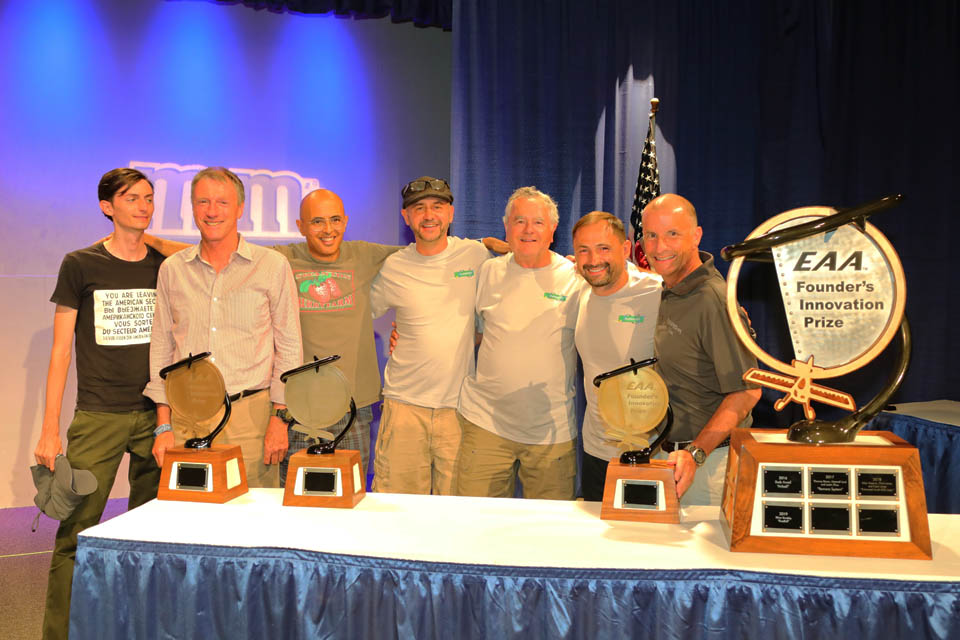FlyONSPEED Wins Founder’s Innovation Prize Grand Championship
By Sam Oleson
July 28, 2021 – FlyONSPEED was announced as the 2021 Founder’s Innovation Prize Grand Championship winner during “An Evening With Innovators” at Theater in the Woods on Tuesday evening.
FlyONSPEED submitted by the team of Mike Vaccaro, EAA 152409, Lenard Iszak, EAA 817999, Cecil Jones, EAA 255202, Bob Baggerman, EAA 1263294, Christopher Jones, EAA 670032, Philip Starbuck, EAA 1199535, Vern Little, EAA 1372675, and Brian Chesteen, EAA 641295, is a system that simplifies energy management. It provides tested and proven angle-of-attack (AOA), energy, and sideslip cues to the pilot to prevent loss of control. It also provides overload (g) and airspeed warning. AOA cueing and full flight envelope warning is accomplished using simple, intuitive audio cues allowing the pilot’s eyes to remain outside of the cockpit during takeoff, maneuvering flight, approach, and landing. Similar systems and aural cues have been used successfully by the military for decades. The system uses $250 worth of readily available through-hole components in a design that is intended for ease of production or assembly by persons with basic electronic skills. It is packaged in a 4.2-by-3.3-by-1.2-inch housing that weighs 10 ounces. An optional, small visual “energy display” that integrates airspeed, g, and performance-based AOA cues to complement the aural system. This $100 COTS visual display can be mounted in a head-up location. The system is completely stand-alone and can be installed in any airplane with an electrical system.
As a nonprofit, open-source organization composed of volunteer aviation professionals, FlyONSPEED was started five years ago because its members thought it would be beneficial for the general aviation community.
“We’re doing this because it’s a good thing to do,” Mike Vaccaro said. “We’ll use the proceeds from Tuesday to put units in production, but we also hope that somebody notices our work, whether it’s Garmin, Dynon, or whomever. The heart of what we do is really just in the software. We build the hardware because this has to be something you can put in any airplane, and it’s got to be inexpensive. We’ve done that. What we do is research development test flying and show folks what’s doable. We’re pushing for a paradigm shift in general aviation. We changed things in the military about 50 years ago to reduce loss-of-control mishaps and were very successful. … We have taken some things that worked really well in the military and married them with general aviation physics. We’ve built everything and developed the training resources to go with it.”
Airball, submitted by Ihab Awad, EAA 1161540, took second place on Tuesday night. Airball is a comprehensive approach to measuring and displaying air data. Airball is a novel visualization that combines all aspects of the relative wind into a single, easy-to-understand mental picture for pilots, and a series of educational and training tools around that mental model. To provide comprehensive air data for this visualization, the Airball project created a low-cost, open-source sensor platform built using 3D printing and commodity electronics. The project also created a daylight-visible display system, low-cost mounting hardware, an Android app, and more. The Solar Pilot Guard System, submitted by Colin Michael Foale, EAA 1040911, took third place. Solar Pilot Guard is a solar-powered, wing-mounted probe with a tail-mounted, solar-powered inertial measurement unit. The SPG-S prompts an audio corrective control response by the pilot when loss of control (LOC) is imminent. SPG-S prevents LOC caused by inadvertent stall and incipient spin, or high-speed exceedance leading to flutter, load exceedance, and structural failure, and with the tail data SPG-S can detect sudden environmental changes such as upset rolling events, as well as downdrafts and updrafts that require immediate pilot response to prevent LOC.
Other contestants at the Founder’s Innovation Prize on Tuesday night were Ed Wischmeyer’s Expanded Envelope Exercises and Ray Kwong’s Epic Optix.
The Expanded Envelope Exercises, submitted by Ed Wischmeyer, EAA 18879, addresses cognitive unavailability in pilots. E3 is a set of fun, challenging, and rewarding exercises that a pilot can do in most any normal category airplane — less than 60-degree bank, 30-degree pitch, 2g’s, and no spins. Because a pilot can fly E3 in his or her own airplane, E3 is affordable and accessible. Unlike dissimilar aircraft training, E3 benefits do not suffer from effects of incomplete transfer from the training airplane to the pilot’s own.
Epic Optix, submitted by Ray Kwong, EAA 1250962, was introduced at EAA AirVenture Oshkosh 2017 as the Epic Eagle Head Up Display 1.0, while the Eagle 2.0 and Graphics Processing Unit was introduced in 2018. The main features of both HUDs are fully portable “carry-on” equipment that’s superior to military/commercial HUD optical performance, while its industrial design accommodates most general aviation cockpits and is Wi-Fi capable via a smartphone, tablet, or laptop to mirror electronic flight bag graphics/avionics. The Eagle 2.0 with GPU-V features video received from an external camera (thermal, visible, or night vision), and the GPU-V then processes the video and overlays it with graphics to provide EVS (enhanced vision system).
This year’s judging panel included Pat Anderson, professor at Embry-Riddle Aeronautical University; Gregory Feith, former senior air safety investigator with the National Transportation Safety Board; Dave Morss, renowned test pilot; Dick VanGrunsven, CEO of Van’s Aircraft, and Michael Goulian, EAA director and air show pilot.
The Founder’s Innovation Prize was supported by DS SolidWorks.

